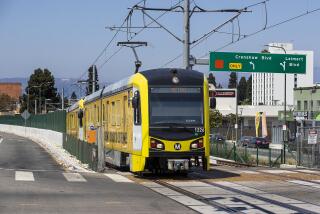Yaroslavsky Backs Busway System as Quick Transit Fix
- Share via
UNIVERSAL CITY — Having written the law that snuffed out new subway construction in Los Angeles, county Supervisor Zev Yaroslavsky proposed an alternative Friday: a modest network of new lanes reserved for extra-long buses.
The proposal, offered at a meeting of Valley politicians and transit planners, echoed a plea for simplicity repeated by most of the speakers. It also reflected a growing sentiment that solutions to choked freeways and overcrowded buses are likely to come on rubber tires rather than metal rails.
“You have to have the courage to try the simple solution,” Yaroslavsky said, adding that a busway system could be built within two years at about 5% of the cost of subways. Like Mayor Richard Riordan before him, Yaroslavsky said he had been won over by the rapid bus system of Curitiba, Brazil. Riordan, Yaroslavsky and 22 others visited the city in January to check out its network of express bus lanes.
A city of about 1.8 million, Curitiba uses triple-length buses that carry as many as 270 people on some routes, the journey made faster by traffic lights timed to let buses pass. The vehicles stop once a mile, and trips are further accelerated by collecting fares before passengers board the bus.
“Curitiba shows us that ingenuity and courage can produce positive results,” said Riordan, who showed the audience a video of the Brazilian buses.
About 100 people attended the transit summit, sponsored by the Economic Alliance of the San Fernando Valley, at the Sheraton Universal Hotel. The meeting follows two others held in late 1997--a time when Valley leaders were beginning to realize the Metropolitan Transportation Authority’s long-promised subway would likely not extend past North Hollywood.
Shifting Debate ‘to Things That Work’
Last November, voters exasperated by construction delays and cost overruns approved Yaroslavsky’s ballot initiative banning the use of transit sales taxes to build more subways.
Now, several speakers said, momentum is building to try simpler and cheaper transit options--”shifting the transportation debate away from utopian, quasi-solutions to things that work,” in the words of Assemblyman Wally Knox (D-Los Angeles).
One small-scale fix proposed for the region is a $13.1-million project to widen the interchange between the San Diego and Ventura freeways, a plan Knox has been pushing for months. Caltrans is designing two additional lanes for the crowded junction.
Yaroslavsky proposed building bus lanes on a variety of broad streets and two old railroad corridors, the Burbank-Chandler route across the San Fernando Valley and Exposition Boulevard downtown. Riordan has suggested a similar route.
The Valley portion of the system would begin at the North Hollywood Metro Red Line station, following the Burbank-Chandler right-of-way west to Canoga Avenue. It would continue north up Canoga to the Chatsworth Metrolink station. Another route would run along Van Nuys Boulevard, from Ventura Boulevard to the Sylmar Metrolink station.
On Thursday, an MTA committee approved a plan to start a pilot rapid-bus system along Ventura and Topanga Canyon boulevards but earmarked no money for the effort.
Yaroslavsky said his proposal would not disrupt existing traffic because the bus lanes could be built on streets wide enough to accommodate extra lanes along the center median. He estimated the Valley segment could be built for less than $500 million.
“Let’s stop arguing,” Yaroslavsky said. “Let’s stop talking. Let’s just try something. . . . If you want to see something done in the next 24 months, then this is the way to go.”
Disavowing ‘Petty Politics and Jealousy’
Glendale City Councilman Sheldon Baker described progress on the Valley transit zone, a proposed coalition of nine cities that would run the Valley’s bus system. To win approval, the zone must show that the MTA is unable to provide cost-effective service.
Baker said the zone would be governed by nine board members, including four from the Valley portion of Los Angeles. The cities of Glendale, Burbank, San Fernando and La Canada Flintridge would choose two board members, while the cities of Calabasas, Agoura Hills, Westlake Village and Hidden Hills would elect a single representative. The remaining two board members would represent Los Angeles County.
Major decisions would require a vote of seven, Baker said.
“Everybody needs everybody else to make mega-decisions,” he said. “Petty politics and jealousy are not going to rule the day.”
Researchers from the Reason Public Policy Institute, part of a nonprofit foundation that often critiques transit policy, explained proposals for high-occupancy toll lanes on the San Diego and Ventura freeways.
These carpool lanes would be open to motorists traveling solo who paid a fee to use them, said Robert Poole, president of the Reason Foundation. The lanes are already being used in Orange and San Diego counties, with fees ranging from 75 cents for an early morning trip to $4 at the height of the Friday afternoon rush-hour.
Assemblyman Bob Hertzberg (D-Sherman Oaks) said that at the last transit summit 16 months ago, his message was, “Just do it.”
“I think my message today is that it’s getting done,” he said. “There seems to be greater consensus to move toward buses.”
(BEGIN TEXT OF INFOBOX / INFOGRAPHIC)
Proposed Bus Route
Supervisor Zev Yaroslavsky on Friday propsed building bus lines a variety of broad streets and old raillroad corridors, including the Burbank-Chandler route across the San Fernando Valley.
*
RAIL LINE ENDORSED
Assembly Speaker Antonio Villaraigosa, breaking with Bus Riders Union, said he will back light rail line between downtown and Pasadena. B4
More to Read
Sign up for Essential California
The most important California stories and recommendations in your inbox every morning.
You may occasionally receive promotional content from the Los Angeles Times.










